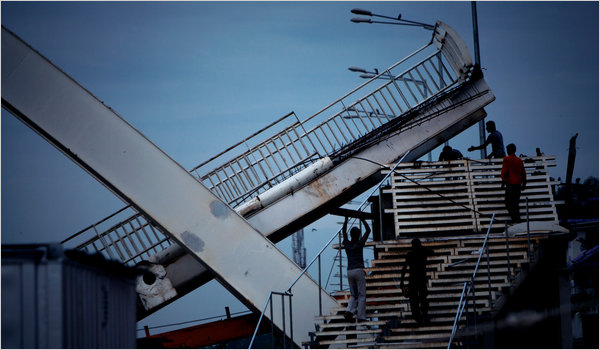
Filthy. Stinky. Corrupt. Dengue. Fetid. Unsafe.
Even for a country like India, long inured to the fiascos created by its bungling and corrupt politicians, the adjectives accompanying the Commonwealth Games (CWG) seem like a new low.
It was supposed to have been different, only it never stood a chance.
The Games involve athletes from members of the Commonwealth of Nations, most of which were formerly part of the British Empire. The bidding process to host the Games is intensely competitive, and Delhi won hosting rights for the 2010 Games in 2003.
Similar to the 2008 Beijing Olympics, this was supposed to have been India’s moment in the sun. “Brand India” was going to be a showcase of the old and new – a sleek marriage of the country’s technological and corporate prowess with that of its exotic traditions and colorful culture.
Instead, Indians have watched mortified as images of soiled beds and water logged apartments have made their way around the world. Understandably, not many appreciate the irony that the once promised “best ever” games could end up as the worst ever in the Commonwealth Games Federation’s history.
Its one thing not being able to live up to Beijing’s dazzling display; its another thing to become the very antithesis of it.
The international media and leaders from around the world have stepped up their criticism of the “unlivable conditions” in the Games Village. Several top athletes have refused to participate, citing health and safety concerns. As if the threats of stagnant water, stray dogs, feces and dengue-causing mosquitoes weren’t enough, a new steel and concrete bridge next to the CWG venue came crashing down this week, promptly followed next day by chunks of a ceiling in the complex’s weightlifting arena.
Predictably, the local organizers have been able to come up with a litany of highly entertaining excuses for the mess, each designed to make an already bad situation worse.
They crossly wagged their fingers at the media, taking them to task for making much ado about nothing. That bridge collapse? “Minor,” and besides, it was meant to be used by the common man, not the athletes, so it doesn’t count. That “filthy” athletes Village? Really, Westerners can sometimes be just a tad too fussy about hygiene. Indians apparently are perfectly fine with stagnant puddles of water and soiled toilets. The small chunks of ceiling? No, no, not because of any design flaw, but rather a consequence of some trespasser walking on some newly laid tiles.
How was a trespasser able to get through the “tight” security?
[silence]
The Games were originally supposed to have cost less than $100 million. Today, cost estimates run anywhere from $3 to $10 Billion. The extent of corruption has been breathtaking, with reports of $80 toilet paper rolls and bids worth millions awarded to fly-by-night companies.
Most Indians are seething and humiliated. Economists like Moody’s predict that the stories will irreparably damage India’s appeal to investors. New Delhi has rushed in to salvage what’s left after the reports managed to outrage even the country’s stoic prime minister, famous for his phlegmatic disposition.
A Wall Street Journal columnist, perfectly tongue-in-cheek, commended the much maligned chairman of the CWG Committee in India, Suresh Kalmadi, for his brilliant strategy and cunning:
“With world-class athletes bailing on the Games right and left…[Kalmadi] has managed to concoct such a gigantic fiasco on almost all fronts that the decks are now being cleared for Indian athletes to excel across the board and win a fistful of medals that they otherwise would not.”